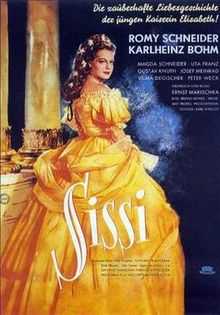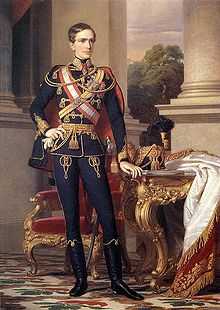Sissi (film)
| Sissi | |
|---|---|
 Theatrical release poster | |
| Directed by | Ernst Marischka |
| Produced by |
Karl Ehrlich Ernst Marischka |
| Written by | Ernst Marischka |
| Starring |
Romy Schneider Karlheinz Böhm Magda Schneider Uta Franz Gustav Knuth Vilma Degischer Josef Meinrad |
| Music by | Anton Profes |
Release dates |
|
Running time | 102 min. |
| Country | Austria |
| Language | German |
Sissi is a 1955 Austrian film directed by Ernst Marischka and starring Romy Schneider, Karlheinz Böhm, Magda Schneider, Uta Franz, Gustav Knuth, Vilma Degischer and Josef Meinrad. The film is based on the play Sissys Brautfahrt (Sissy's Bridal Journey) by Ernst Décsey and Gustav Holm. Sissi is the first installment in the trilogy of films about Empress Elisabeth of Austria, who was known to her family as "Sissi". It was followed by The Young Empress and Fateful Years of an Empress.
Plot

Princess Elisabeth, nicknamed "Sissi", is the second oldest daughter of Duke Maximilian Joseph in Bavaria and Princess Ludovika of Bavaria. She is a carefree, impulsive and nature-loving child. She is raised with her seven siblings at the family seat Possenhofen Castle on the shores of Lake Starnberg in Bavaria. She has a happy childhood free of constraints associated with her royal status.
With her mother and her demure older sister Helene (called "Néné"), 16-year-old Sissi travels from Possenhofen to the spa town of Bad Ischl in Upper Austria. Ludovika's sister, Archduchess Sophie, is the mother of the young emperor Franz Joseph I of Austria. Helene is called by Archduchess Sophie to meet the young emperor Franz Joseph in the imperial villa so that the two might be immediately engaged. Sissi is unaware of the real reason for the journey and is forbidden by her aunt to participate in any social events due to her rebellious ways.

Sissi spends her time fishing in the forest where by chance she meets Franz Josef. The emperor is unaware that the girl is his cousin Sissi. He takes a liking to her and invites her for an afternoon hunting trip in the Alps. They meet as arranged in the mountains where they talk and become acquainted. Sissi falls in love with him but does not reveal her true identity. During their trip, Sissi learns of the planned marriage between Franz Joseph with her sister. The Emperor confesses that he envies the man who will marry Sissi and confesses that he feels no connection to Néné. Upon hearing his indirect declaration of love, Sissi becomes distraught due to her loyalty to Néné. She runs away from Franz Joseph without any explanation.
When Sissi returns to their residence, Néné reveals the reason for the trip to Bad Ischl: to become engaged with Franz Joseph. Unexpectedly, Franz Josef's brother, Carl-Ludwig, arrives and Sissi is invited by the Archduchess to act as his partner at the Emperor's birthday celebration. At his birthday party, Franz Joseph is suddenly confronted by Sissi's appearance there with her mother and sister. He realises who Sissi is and tries to talk to her, openly confessing his love and asking her to marry him. Sissi rejects Franz Joseph in order not to betray her sister. He defies his mother's reservations and Sissi's resistance and announces, to the surprise of his guests, his betrothal to Sissi. Néné is heartbroken and leaves the party crying. Sissi, in a state of shock, is forced to obey the Emperor's wishes.
In Possenhofen, preparations for the wedding have started. Sissi is not excited for her impending marriage, as the hurt Néné has left for an indefinite period. For her sister's sake, Sissi attempts to break her engagement, however, Néné returns with a new suitor, Maximilian Anton, Hereditary Prince of Thurn and Taxis. The sisters reunite and Néné gives her blessings to Sissi for her marriage.
For the wedding ceremony, Sissi travels with her family on the steamboat "Franz Joseph" down the Danube to Vienna. People line the banks, waving flags and cheering their future Empress. As part of a grand procession, Sissi enters the city in a gilded carriage. The wedding takes place in the Augustinian Church on April 24, 1854.
Cast
- Romy Schneider as Empress Elisabeth of Austria, or "Sissi"
- Karlheinz Böhm as Emperor Franz Joseph I of Austria
- Vilma Degischer as Archduchess Sophie, Franz Joseph's mother
- Erich Nikowitz as Archduke Franz Karl, Franz Joseph's father
- Peter Weck as Archduke Karl Ludwig, Franz Joseph's brother
- Magda Schneider as Duchess Ludovika in Bavaria, Sissi's mother and Sophie's sister
- Gustav Knuth as Duke Max in Bavaria, Sissi's father
- Uta Franz as Princess Helene in Bavaria, or "Nené", Sissi's older sister
- Josef Meinrad as Gendarmerie-Major Böckl
- Richard Eybner as Postmaster of Ischl
Filming locations
Sissi was filmed in the original places locations where the Empress visited. These locations included Schönbrunn Palace, the Imperial Villa in Bad Ischl, St. Michael's Church and Madeira, Portugal.
Reception
Sissi was viewed by 20 to 25 million people in cinemas. It is one of the most successful German-speaking movies. The movie was followed by the The Young Empress in 1956 and Fateful Years of an Empress in 1957. In 1962, a condensed version of the trilogy was released in English under the title Forever My Love. The trilogy is a popular Christmas television special, and is shown on channels in German-speaking countries and Hungary.[1] The Empress' date of birth on Christmas Eve 1837 adds to the appeal of the film as a Christmas special.
The success of the movie marked Empress Elisabeth's entrance to popular culture which made the historical figure even more legendary. The popularity of the films attracted tourists to places which were associated with the Empress, specifically those in Austria. The popularity also led to the creation of the 1992 musical Elisabeth, which became the most successful German-language musical of all time. The trilogy was parodied in the 2007 animated film Lissi.
Romy Schneider's role as Elisabeth is considered her acting breakthrough. She became synonymous with her role in the film, even as she progressed in her acting career. Schneider reprised the role of Elisabeth in Luchino Visconti's 1972 film Ludwig, this time portraying the Empress as a mature yet cynical woman.
The films have been dubbed in languages including French, English, Spanish and Japanese. Sissi was very popular when it aired on Mainland Chinese television in the 1980s.[2]
Notes
- ↑ "Sissi I. – A magyarok királynéja", www.port.hu
- ↑ Osnos, Evan. "The Grand Tour." The New Yorker. April 18, 2011. 6. Retrieved on May 19, 2012.
Further reading
- Heidi Schlipphacke: Melancholy Empress: Queering Empire in Ernst Marischka's „Sissi“ Films. In: Screen. 51, 3, 2010, ISSN 0036-9543, 232–255.
External links
- Sissi at the Internet Movie Database
- Official Site (German)
| ||||||||||